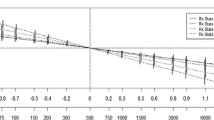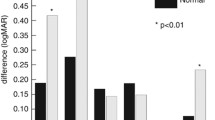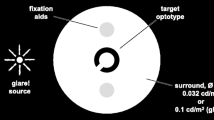Abstract
Purpose
To determine the repeatability of mesopic high-contrast (HC) and low-contrast (LC) visual acuity (VA) measurements made at distance and near in healthy young individuals. While the repeatability of photopic VA is well-known, there is a lack of information with regard to the repeatability of VA measured under low luminance conditions.
Methods
In two different sessions 1 week apart, best-corrected monocular VA was determined using HC (96 %) and LC (10 %) ETDRS charts under mesopic luminance conditions (0.75 cd/m2) at distance (HCD, LCD) and near (HCN, LCN) in 47 healthy subjects aged 22.9 ± 6.8 years. Repeatability was estimated by the Bland and Altman method, whereby the mean difference (MD) and the 95 % limits of agreement were determined as the coefficient of repeatability (COR).
Results
Mean logMAR VA values were HCD = 0.09, LCD = 0.44, HCN = 0.21, and LCN = 0.57. Mean differences in measurements between sessions 1 and 2 were not significant, and low in clinical terms (≤1 letter). Repeatability was better for the distance measurements at both high and lowcontrast (COR HCD ±0.11 and COR LCD ±0.11 logMAR vs COR HCN ±0.15 and COR LCN ±0.16 logMAR), and MDs were also slightly closer to zero for the distance measurements. Similar repeatability was observed between HC and LC VA, both at distance and near.
Conclusions
In mesopic conditions, ETDRS charts offer repeatable best-corrected monocular VA measurements. The criterion for a significant change in logMAR VA was 1 line at distance and 1.5 lines at near.

Similar content being viewed by others
References
Raasch TW, Bailey IL, Bullimore MA (1998) Repeatability of visual acuity measurement. Optom Vis Sci 75(5):342–348
Petzold A, Plant GT (2006) Clinical disorders affecting mesopic vision. Ophthalmic Physiol Opt 26:326–341
Dhamdhere K, Schneck M, Bearse MJ, Lam W, Barez S, Adams A (2014) Assessment of macular function using the SKILL card in adults with type 2 diabetes mellitus. Invest Ophthalmol Vis Sci 55:3368–3374
Heckenlively J (1988) Retinitis pigmentosa. JB Lippincott Co, Philadelphia
Morimura H, Berson E, Dryja T (1999) Recessive mutations in the RLBP1 gene encoding cellular retinaldehyde-binding protein in a form of retinitis punctata albescens. Invest Ophthalmol Vis Sci 40:1000–1004
Nakamura M, Lin J, Ito Y, Miyake Y (2005) Novel mutation in RLBP1 gene in a Japanese patient with retinitis punctata albescens. Am J Ophthalmol 139:1133–1135
Fujita K, Shinoda K, Matsumoto CS, Imamura Y, Mizutani Y, Tanaka E, Mizota A, Oda K, Yuzawa M (2013) Low luminance visual acuity in patients with central serous chorioretinopathy. Clin Exp Optom 96(1):100–105
Keltner J, Thirkill C, Yip P (2001) Clinical and immunologic characteristics of melanoma-associated retinopathy syndrome: eleven new cases and a review of 51 previously published cases. J Neuroophthalmol 21:173–187
Puell MC, Barrio AR, Palomo-Alvarez C, Gómez-Sanz FJ, Clement-Corral A, Pérez-Carrasco MJ (2012) Impaired mesopic visual acuity in eyes with early age-related macular degeneration. Invest Ophthalmol Vis Sci 53:7310–7314
Sunness JS, Rubin GS, Broman A, Applegate CA, Bressler NM, Hawkins BS (2014) Low luminance visual dysfunction as a predictor of subsequent visual acuity loss from geographic atrophy in age-related macular degeneration. Ophthalmology 115(9):1480–1488
Hess R, Woo G (1978) Vision through cataracts. Invest Ophthalmol Vis Sci 17(5):428–435
Hess RF, Carney LG (1979) Vision through an abnormal cornea: a pilot study of the relationship between visual loss from corneal distortion, corneal edema, keratoconus, and some allied corneal pathology. Invest Ophthalmol Vis Sci 18(5):476–483
Tang W, Heng WJ, Lee HM, Fam HB (2006) Efficacy of measuring visual performance of LASIK patients under photopic and mesopic conditions. Ann Acad Med Singap 35:541–546
Lempert P, Hopcroft M, Lempert Y (1987) Evaluation of posterior subcapsular cataracts. With spatial contrast acuity. Ophthalmology 2:14–18
Zadnik K, Mannis MJ, Johnson CA, Rich D (1987) Rapid contrast sensitivity assessment in keratoconus. Am J Optom Physiol Optic 64(9):693–697
Applegate RA, Marsack JD, Thibos LN (2006) Metrics of retinal image quality predict visual performance in eyes with 20/17 or better visual acuity. Optom Vis Sci 83:635–640
Luckiesh M (1944) Test charts representing a variety of visual tasks. Am J Ophthalmol 27:270–275
Plainis S, Murray I, Charman W (2005) The role of retinal adaptation in night driving. Optom Vis Sci 82:682–688
Bailey IL, Lovie JE (1976) New design principles for visual acuity letter charts. Am J Optom Physiol Optic 53(11):740–745
Lovie-Kitchin JE (1988) Validity and reliability of visual acuity measurements. Ophthalmic Physiol Opt 8:363–370
Ferris FL 3rd, Bailey I (1996) Standardizing the measurement of visual acuity for clinical research studies: guidelines from the eye care technology forum. Ophthalmology 103(1):181–182
Klein R, Klein BE, Moss SE, DeMets D (1983) Inter-observer variation in refraction and visual acuity measurement using a standardized protocol. Ophthalmology 90(11):1357–1359
Camparini M, Cassinari P, Ferrigno L, Macaluso C (2001) ETDRS-fast: implementing psychophysical adaptive methods to standardized visual acuity measurement with ETDRS charts. Invest Ophthalmol Vis Sci 42(6):1226–1231
Elliott DB, Sheridan M (1988) The use of accurate visual acuity measurements in clinical anti-cataract formulation trials. Ophthalmic Physiol Opt 8:397–401
Lovie-Kitchin JE, Brown B (2000) Repeatability and intercorrelations of standard vision tests as a function of age. Optom Vis Sci 77(8):412–420
Reeves BC, Wood JM, Hill AR AR (1993) Reliability of high- and low-contrast letter charts. Ophthalmic Physiol Opt 13(1):17–26
Ferris FLR, Kassoff A, Bresnick GH, Bailey I (1982) New visual acuity charts for clinical research. Am J Ophthalmol 94:91–96
Bland JM, Altman DG (1986) Statistical methods for assessing agreement between two methods of clinical measurement. Lancet 1(8476):307–310
Haegerstrom-Portnoy G, Brabyn J, Schneck ME, Jampolsky A (1997) The SKILL card. An acuity test of reduced luminance and contrast. Smith–Kettlewell Institute Low Luminance. Invest Ophthalmol Vis Sci 38(1):207–218
Pesudovs K, Marsack JD, Donnelly WJ 3rd, Thibos LN, Applegate RA (2004) Measuring visual acuity-mesopic or photopic conditions, and high or low contrast letters? J Refract Surg 20(5):S508–S514
Lam AK, Tong C, Tse J, Yu M (2008) Repeatability of near visual acuity measurement at high and low contrast. Clin Exp Optom 91(5):447–452
Siderov J, Tiu AL (1999) Variability of measurements of visual acuity in a large eye clinic. Acta Ophthalmol Scand 77(6):673–676
Cho P, Woo GC (2004) Repeatability of the watterloo four-contrast LogMAR visual acuity chart and near vision test card on a group of normal young adults. Ophthalmic Physiol Opt 24:427–435
Elliott D, Bullimore MA (1993) Assessing the reliability, discriminative ability, and validity of disability glare tests. Invest Ophthalmol Vis Sci 34:108–119
Conflict of interest
All authors certify that they have NO affiliations with or involvement in any organization or entity with any financial interest (such as honoraria; educational grants; participation in speakers’ bureaus; membership, employment, consultancies, stock ownership, or other equity interest; and expert testimony or patent-licensing arrangements) or non-financial interest (such as personal or professional relationships, affiliations, knowledge, or beliefs) in the subject matter or materials discussed in this manuscript.
Author information
Authors and Affiliations
Corresponding author
Rights and permissions
About this article
Cite this article
Barrio, A., Antona, B. & Puell, M.C. Repeatability of mesopic visual acuity measurements using high- and low-contrast ETDRS letter charts. Graefes Arch Clin Exp Ophthalmol 253, 791–795 (2015). https://doi.org/10.1007/s00417-014-2876-z
Received:
Revised:
Accepted:
Published:
Issue Date:
DOI: https://doi.org/10.1007/s00417-014-2876-z




